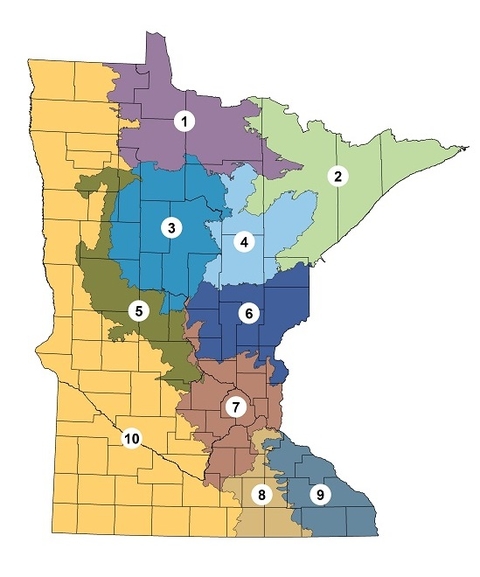For those of you looking to rewild your backyard woods in east-central Minnesota, we recommend species that are native to the Eastern Deciduous Forest, climate resilient, and beneficial for little critters like bats, birds, and pollinators that are essential for ecosystem functioning.
These recommendation lists are targeted for the region that ecologists call the Mille Lacs Uplands and Glacial Lake Superior Plain, which includes Pine, Kanabec, and Mille Lacs counties, and parts of Carlton, Aitkin, Crow Wing, Morrison, Benton, Chisago, and Isanti counties (region 6 on the map).
Some of the tree species we recommend are ones you may have never heard of — for example, chittamwood is a tree native to Texas in the far southern range of the Eastern Deciduous Forest. This may seem like a large geographic jump for this species, but chittamwood is predicted to perform well in the future climate of Minnesota. Planting species like chittamwood is an example of assisted migration, which is one of the techniques that we can use to adapt and transition our forests for Minnesota’s future climate.
Recommended trees for the Mille Lacs Uplands and Glacial Lake Superior Plain
| Common name | Scientific name | Height | Soil preference | Light requirement |
|---|---|---|---|---|
| Sugar maple | Acer saccharum | 80 ft. | Evenly-moist, well-drained | Full to part sun |
| Yellow birch | Betula alleghaniensis | 45 ft. | Deep well-drained loam | Full sun to shade |
| Bitternut hickory | Carya cordiformis | 75 ft. | Evenly-moist | Full to part sun |
| Pignut hickory | Carya glabra | 60–80 ft. | Adaptable | Full to part sun |
| Shagbark hickory | Carya ovata | 80 ft. | Dry sandy or rocky soil | Full to part sun |
| Black hickory | Carya texana | 140 ft. | Adaptable | Part shade |
| Mockernut hickory | Carya tomentosa | 85 ft. | Moist to occasionally dry | Full to part sun |
| Sugarberry | Celtis laevigata | 60–80 ft. | Adaptable | Full to part sun |
| Eastern redbud | Cercis canadensis | 30 ft. | Evenly-moist, well-drained | Full to part sun |
| Pagoda dogwood | Cornus alternifolia | 18 ft. | Acidic, evenly-moist | Full to part sun |
| Honeylocust | Gleditsia triacanthos | 60 ft. | Adaptable | Full sun |
| Sweetgum | Liquidambar styraciflua | 60–100 ft. | Well-drained | Full to part sun |
| Yellow-poplar | Liriodendron tulipifera | 80 ft. | Evenly-moist, well-drained | Full sun |
| Osage-orange | Maclura pomifera | 40 ft. | Adaptable | Full sun |
| Red mulberry | Morus rubra | 25–80 ft. | Moist to dry | Full sun to shade |
| Black gum | Nyssa sylvatica | 30–50 ft. | Moist, acidic | Sun to part shade |
| Ironwood | Ostrya virginiana | 65 ft. | Well-drained | Part sun |
| Sycamore | Platanus occidentalis | 75–100 ft. | Adaptable | Full sun |
| Chokecherry | Prunus virginana | 25 ft. | Adaptable | Full sun |
| White oak | Quercus alba | 75 ft. | Well-drained to dry | Full sun |
| Bur oak | Quercus macrocarpa | 75 ft. | Adaptable | Full sun |
| Post oak | Quercus stellata | 50–75 ft. | Moist, well-drained, adaptable | Full sun |
| Chittamwood | Sideroxylon lanuginosum | 20–45 ft. | Evenly-moist, well-drained | Sun to part shade |
| Basswood | Tilia americana | 90 ft. | Mesic loam or alluvial soils | Sun to part shade |
| American elm | Ulmus americana | 35–45 ft. | Average to wet soil | Sun to part shade |
Recommended plants for the Mille Lacs Uplands and Glacial Lake Superior Plain
| Common name | Scientific name | Height | Soil preference | Light requirement |
|---|---|---|---|---|
| Hog peanut | Amphicarpaea bracteata | 1–5 ft. | Evenly-moist | Part to full shade |
| American hazelnut | Corylus americana | 8 ft. | Evenly-moist | Full to part sun |
| Beaked hazelnut | Corylus cornuta | 12 ft. | Medium textured moist | Full sun |
| Large-leaved aster | Eurybia macrophylla | 60 in. | Adaptable | Part to full shade |
| Clayton's sweet cicely | Osmorhiza claytonii | 24 in. | Medium-wet to medium-dry | Shade |
| Prickly gooseberry | Ribes cynosbati | 6 ft. | Average to moist | Part sun |
| Common blackberry | Rubus allegheniensis | 6 ft. | Well-drained, organic-rich | Full to part sun |
| Dwarf raspberry | Rubus pubescens | 4–6 in. | Moist, organic-rich | Full sun to shade |
| Zigzag goldenrod | Solidago flexicaulis | 36 in. | Medium-wet to medium-dry | Full to part sun |
| Early meadow-rue | Thalictrum dioicum | 36 in. | Well-drained, organic-rich | Full to part sun |
| Large-flowered bellwort | Uvularia grandiflora | 16 in. | Alkaline, well-drained loam | Sun to part shade |
| Downy yellow violet | Viola pubescens | 6 in. | Average to medium-wet | Part shade |
| Rugulose violet | Viola rugulosa | 12 in. | Dry to average moisture | Part to full shade |
What’s next?
We’ll be releasing tree and plant lists for the rest of the state in the coming months. These lists are intended for those of you who own or steward backyard woods that are less than 20 acres in size. Sign up here to receive our monthly newsletter to be notified of future posts in this series.


